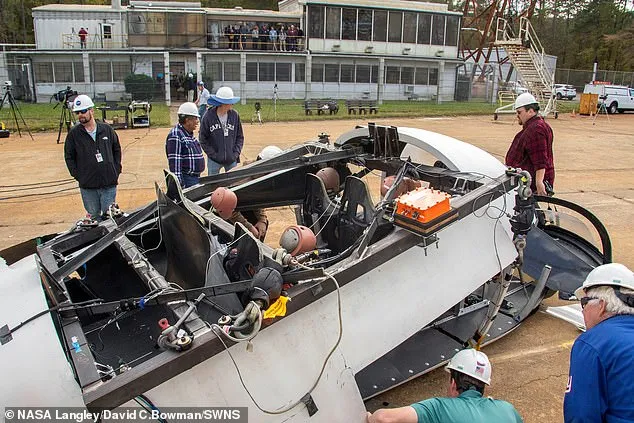NASA researchers recently completed a full-scale crash test of an electric vertical takeoff and landing (eVTOL) concept vehicle at the Landing and Impact Research (LandIR) facility at NASA’s Langley Research Center in Hampton, Virginia. The eVTOL was a “Lift+Cruise” test article developed by the Revolutionary Vertical Left Technology (RVLT) project in another effort for NASA to advance research for the Advanced Air Mobility (AAM) mission.
“The test was a great success for the crash-worthiness team at Langley,” said Justin Littell, research assistant for Langley’s Structural Dynamics Branch. “We successfully tested the eVTOL vehicle concept, representing a six-passenger, high-wing, overhead mass, multiple-rotor vehicle, obtaining more than 200 channels of data, and collecting over 20 onboard and offboard camera views.”
NASA performed a variety of experiments. Several seat configurations were tested, including a NASA energy-absorbing concept, various sizes of crash test dummies to study the effects of crash loads on occupants of all sizes, and a modular NASA-developed energy-absorbing composite subfloor.
The floor crushing and seat stroking were the first events. The subfloor and energy-absorbing seats worked as intended, limiting the impact’s effect on the crash test dummies. The overhead structure collapsed in the second event. The impact of the collapsed overhead structure on the crash test dummies is still being determined.
An overhead mass was created to represent the wing structure, rotor, and battery in this test. It was decided to assume that the entire weight of the overhead structure was over the cabin. In a crash, many other overhead-mass configurations may behave differently.
The test data will be used to improve modelling techniques and will be shared with the AAM community for discussion. “Our computational pretest models did a good job predicting the composite deformation until the overhead structural failure,” said Littell. “However, the computational models did not predict the overall collapse as seen in the test.”
The full-scale testing data will be used to improve the simulation models so that future predictions are more accurate. The data will also be used to evaluate potential test conditions and configurations for a drop test of a second Lift+Cruise test article, which is tentatively scheduled for testing in late 2023.

